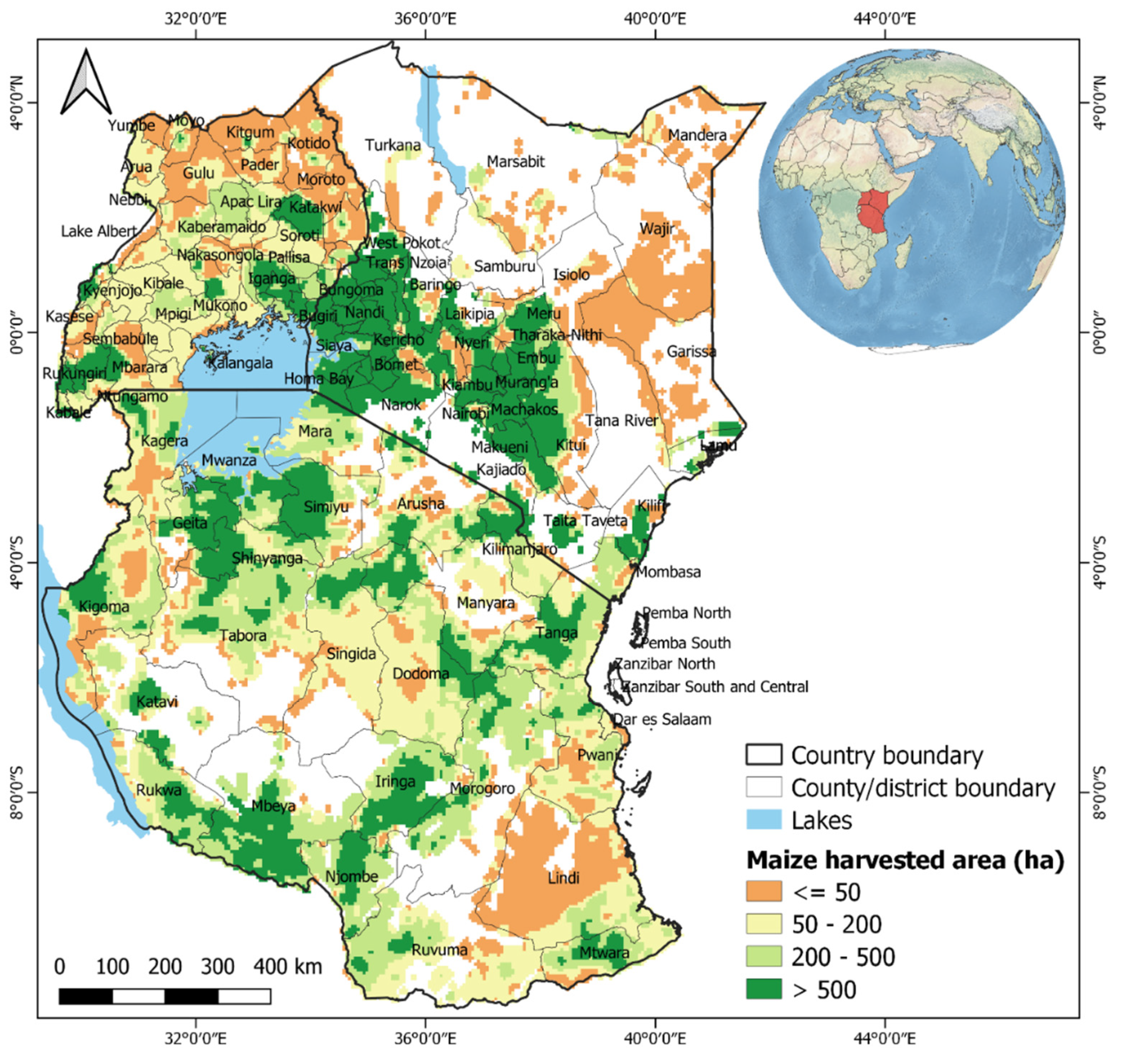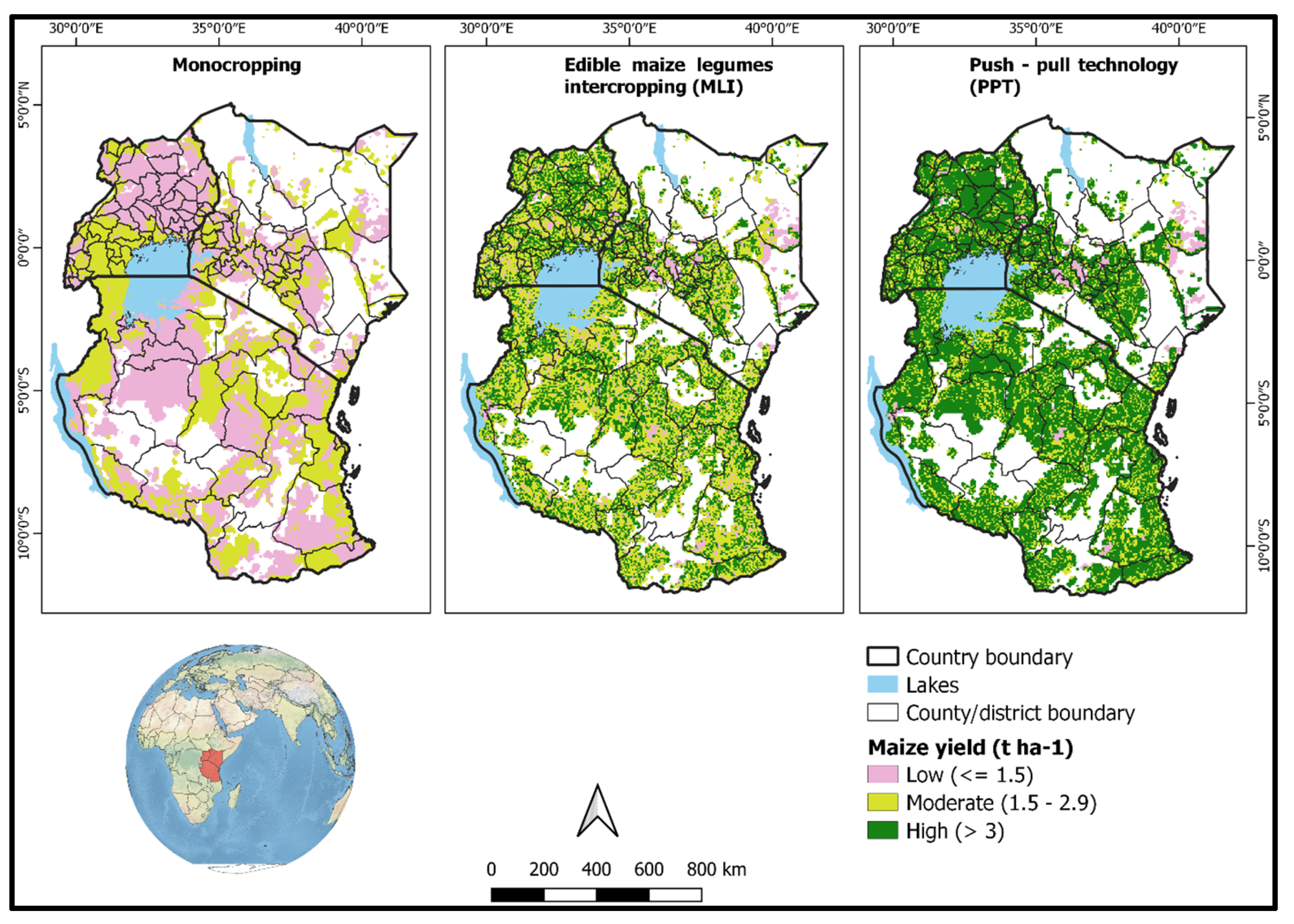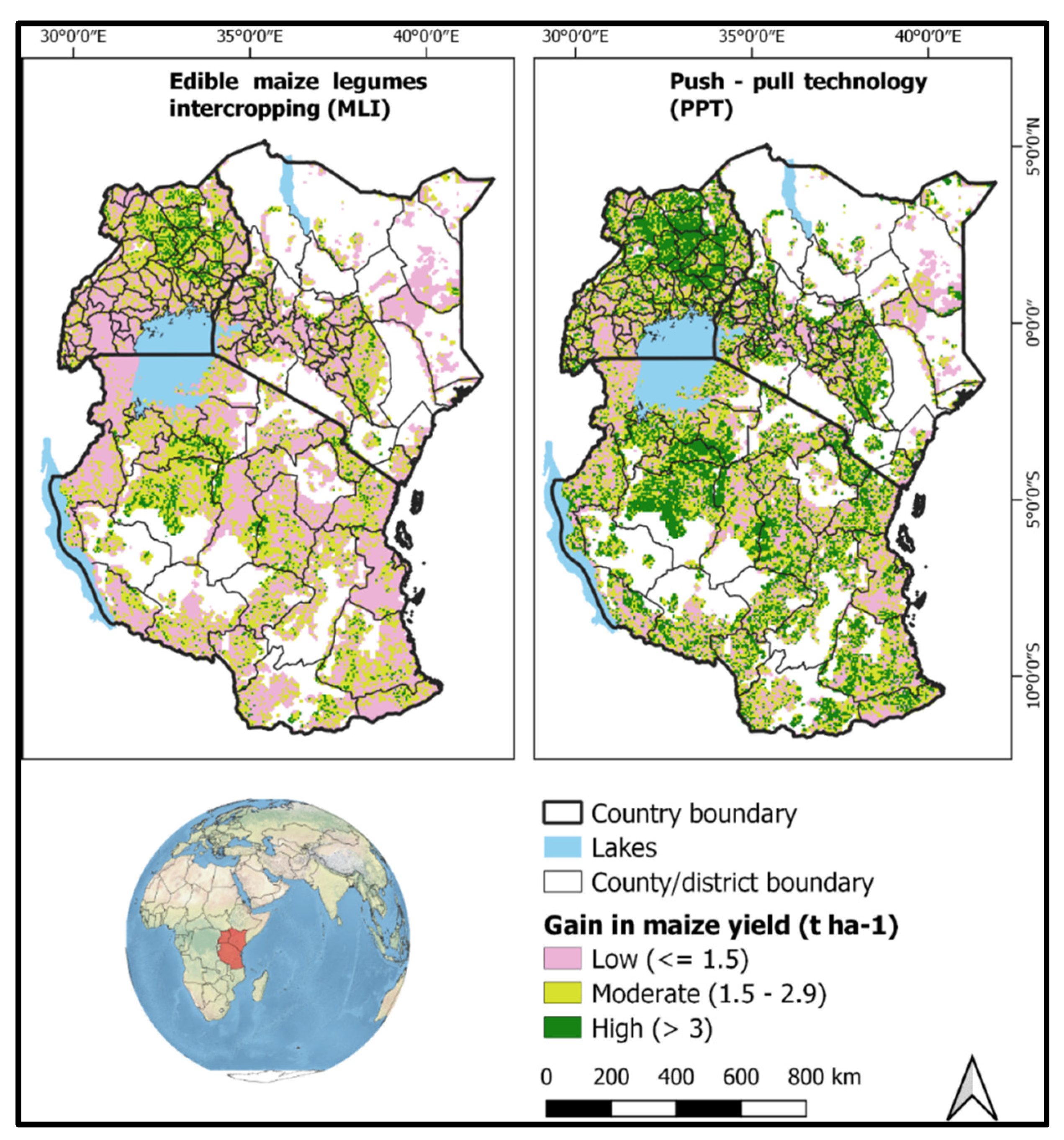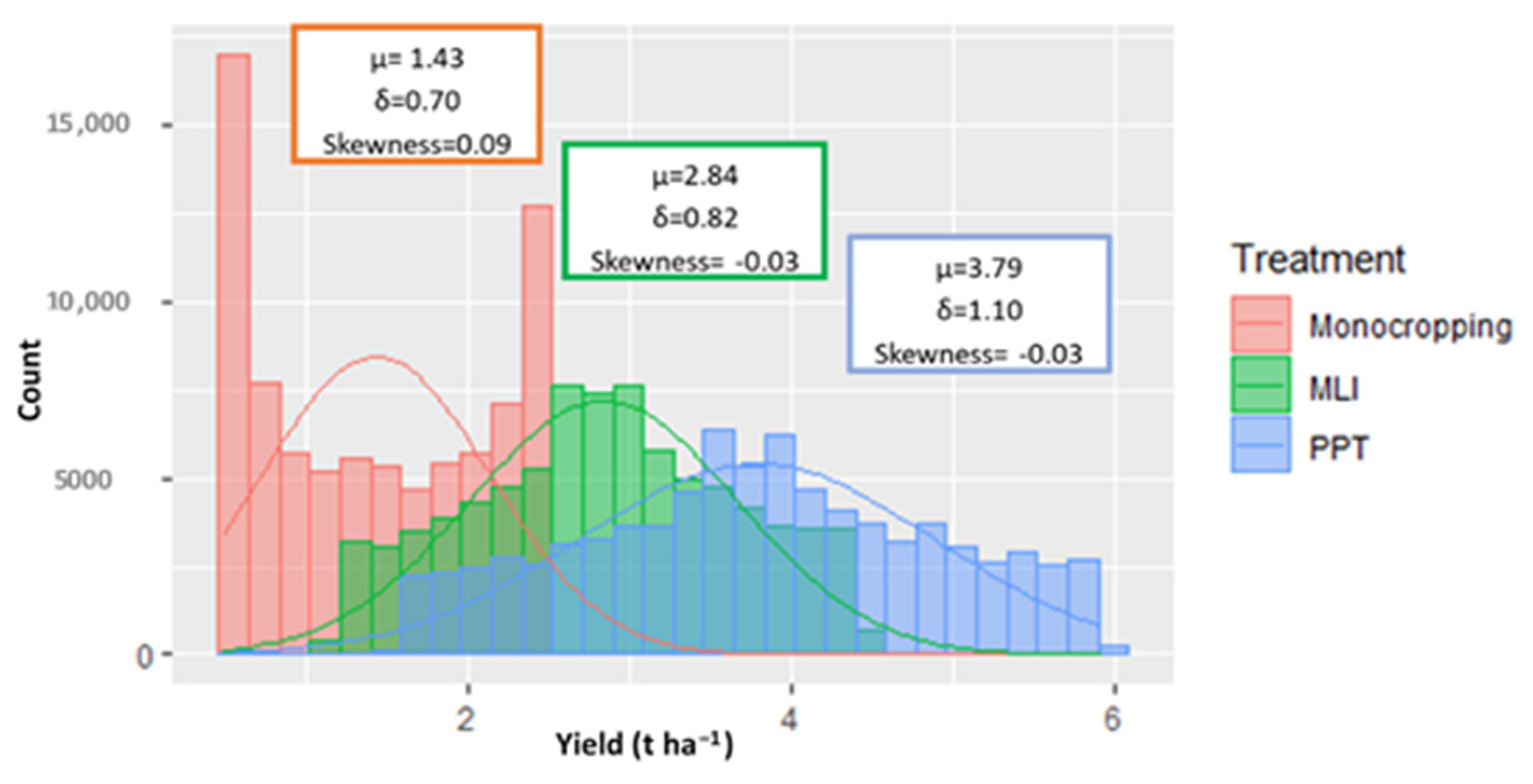Data-Driven Artificial Intelligence (AI) Algorithms for Modelling Potential Maize Yield under Maize–Legume Farming Systems in East Africa
Abstract
:1. Introduction
2. Materials and Methods
2.1. Area of Interest
2.2. Maize Yield Data and Predictor Variables
2.3. Assumption
2.4. Model Development and İmplementation
2.5. Mapping Maize Yield in the Study Area
3. Results
4. Discussion
5. Conclusions
Author Contributions
Funding
Institutional Review Board Statement
Informed Consent Statement
Data Availability Statement
Conflicts of Interest
References
- Thorne, P.J. Maize as Food, Feed, and Fertiliser in Intensifying Crop-livestock Systems in East and Southern Africa: An Ex Ante Impact Assessment of Technology Interventions to Improve Smallholder Welfare; ILRI (aka ILCA and ILRAD): Nairobi, Kenya, 2002; Volume 11. [Google Scholar]
- Okweche, S.I.; Ogunwolu, E.O.; Adeyemo, M.O. Parameters, Interrelationships with Yield and use of Carbofuran to Control Stem Borers in Maize (Zea mays L.) at Makurdi in the Nigerian Southern Guinea Savanna. Greener J. Agric. Sci. 2013, 3, 702–708. [Google Scholar] [CrossRef]
- Niassy, S.; Agbodzavu, M.K.; Kimathi, E.; Mutune, B.; Abdel-Rahman, E.F.M.; Salifu, D.; Hailu, G.; Belayneh, Y.T.; Felege, E.; Tonnang, H.E.Z.; et al. Bioecology of fall armyworm Spodoptera frugiperda (J. E. Smith), its management and potential patterns of seasonal spread in Africa. PLoS ONE 2021, 16, e0249042. [Google Scholar] [CrossRef] [PubMed]
- Mustroph, A. Improving Flooding Tolerance of Crop Plants. Agronomy 2018, 8, 160. [Google Scholar] [CrossRef] [Green Version]
- Gomez-Zavaglia, A.; Mejuto, J.; Simal-Gandara, J. Mitigation of emerging implications of climate change on food production systems. Food Res. Int. 2020, 134, 109256. [Google Scholar] [CrossRef]
- Dessie, A.B.; Abate, T.M.; Mekie, T.M.; Liyew, Y.M. Crop diversification analysis on red pepper dominated smallholder farming system: Evidence from northwest Ethiopia. Ecol. Process. 2019, 8, 50. [Google Scholar] [CrossRef] [Green Version]
- Launer, J. Monkey Business. Postgrad. Med. J. 2015, 91, 117–118. [Google Scholar] [CrossRef] [Green Version]
- Tonnang, H.E.; Hervé, B.D.; Biber-Freudenberger, L.; Salifu, D.; Subramanian, S.; Ngowi, V.B.; Guimapi, R.Y.; Anani, B.; Kakmeni, F.M.; Affognon, H.; et al. Advances in crop insect modelling methods—Towards a whole system approach. Ecol. Model. 2017, 354, 88–103. [Google Scholar] [CrossRef] [Green Version]
- Peace, N. Impact of Climate Change on Insects, Pest, Diseases and Animal Biodiversity. Int. J. Environ. Sci. Nat. Resour. 2020, 23, 151–153. [Google Scholar] [CrossRef]
- Ari, D.; Alagoz, B.B. An effective integrated genetic programming and neural network model for electronic nose calibration of air pollution monitoring application. Neural Comput. Appl. 2022, 34, 12633–12652. [Google Scholar] [CrossRef]
- Kfir, R.; Overholt, W.A.; Khan, Z.R.; Polaszek, A. Biology and Management of Economically Important Lepidopteran Cereal Stem Borers in Africa. Annu. Rev. Èntomol. 2002, 47, 701–731. [Google Scholar] [CrossRef]
- De Groote, H.; Kimenju, S.C.; Munyua, B.; Palmas, S.; Kassie, M.; Bruce, A. Spread and impact of fall armyworm (Spodoptera frugiperda J. E. Smith) in maize production areas of Kenya. Agric. Ecosyst. Environ. 2020, 292, 106804. [Google Scholar] [CrossRef] [PubMed]
- Johnson, S.J. Migration and the life history strategy of the fall armyworm, Spodoptera frugiperda in the western hemisphere. Int. J. Trop. Insect. Sci. 1987, 8, 543–549. [Google Scholar] [CrossRef]
- Tinoco-Ojanguren, R.; Halperin, D.C. Poverty, Production, and Health: Inhibition of Erythrocyte Cholinesterase via Occupational Exposure to Organophosphate Insecticides in Chiapas, Mexico. Arch. Environ. Health Int. J. 1998, 53, 29–35. [Google Scholar] [CrossRef] [PubMed]
- Maitra, S.; Shankar, T.; Banerjee, P. Potential and Advantages of Maize-Legume Intercropping System. In Maize-Production and Use; IntechOpen: London, UK, 2020. [Google Scholar] [CrossRef] [Green Version]
- Midega, C.A.; Pittchar, J.O.; Pickett, J.A.; Hailu, G.W.; Khan, Z.R. A climate-adapted push-pull system effectively controls fall armyworm, Spodoptera frugiperda (J. E. Smith), in maize in East Africa. Crop. Prot. 2017, 105, 10–15. [Google Scholar] [CrossRef]
- Iqbal, N.; Hussain, S.; Zhang, X.-W.; Yang, C.-Q.; Raza, M.A.; Deng, J.-C.; Ahmad, S.; Ashgar, M.A.; Zhang, J.; Yang, W.; et al. Imbalance Water Deficit Improves the Seed Yield and Quality of Soybean. Agronomy 2018, 8, 168. [Google Scholar] [CrossRef] [Green Version]
- Asseng, S.; Zhu, Y.; Basso, B.; Wilson, T.; Cammarano, D. Simulation Modeling: Applications in Cropping Systems. Encycl. Agric. Food Syst. 2014, 102–112. [Google Scholar] [CrossRef]
- Yu, Y. Crop Yields in Intercropping. Ph.D. Thesis, Wageningen University, Wageningen, The Netherlands, 20 April 2016. [Google Scholar]
- Khan, Z.R.; Midega, C.A.O.; Pittchar, J.O.; Murage, A.W.; Birkett, M.; Bruce, T.; Pickett, J.A. Achieving food security for one million sub-Saharan African poor through push-pull innovation by 2020. Philos. Trans. R. Soc. B Biol. Sci. 2014, 369, 20120284. [Google Scholar] [CrossRef] [PubMed] [Green Version]
- Midega, C.A.O.; Bruce, T.J.A.; Pickett, J.A.; Khan, Z.R. Ecological management of cereal stemborers in African smallholder agriculture through behavioural manipulation. Ecol. Èntomol. 2015, 40, 70–81. [Google Scholar] [CrossRef] [Green Version]
- Hailu, G.; Niassy, S.; Khan, Z.R.; Ochatum, N.; Subramanian, S. Maize-legume intercropping and push-pull for management of fall armyworm, stemborers, and striga in Uganda. Agron. J. 2018, 110, 2513–2522. [Google Scholar] [CrossRef]
- Ndayisaba, P.C.; Kuyah, S.; Midega, C.A.O.; Mwangi, P.N.; Khan, Z.R. Push-pull technology improves carbon stocks in rainfed smallholder agriculture in Western Kenya. Carbon Manag. 2022, 13, 127–141. [Google Scholar] [CrossRef]
- Bell, J.R.; Aralimarad, P.; Lim, K.-S.; Chapman, J.W. Predicting Insect Migration Density and Speed in the Daytime Convective Boundary Layer. PLoS ONE 2013, 8, e54202. [Google Scholar] [CrossRef] [PubMed]
- Liebhold, A.M.; Tobin, P.C. Population Ecology of Insect Invasions and Their Management. Annu. Rev. Èntomol. 2008, 53, 387–408. [Google Scholar] [CrossRef] [Green Version]
- Thornton, P.K.; Jones, P.G.; Alagarswamy, G.; Andresen, J. Spatial variation of crop yield response to climate change in East Africa. Glob. Environ. Chang. 2009, 19, 54–65. [Google Scholar] [CrossRef]
- Shirley, R.; Pope, E.; Bartlett, M.; Oliver, S.; Quadrianto, N.; Hurley, P.; Duivenvoorden, S.; Rooney, P.; Barrett, A.B.; Kent, C.; et al. An empirical, Bayesian approach to modelling crop yield: Maize in USA. Environ. Res. Commun. 2020, 2, 025002. [Google Scholar] [CrossRef]
- Xie, Y. Values and limitations of statistical models. Res. Soc. Strat. Mobil. 2011, 29, 343–349. [Google Scholar] [CrossRef] [PubMed] [Green Version]
- Karpatne, A.; Atluri, G.; Faghmous, J.H.; Steinbach, M.; Banerjee, A.; Ganguly, A.; Shekhar, S.; Samatova, N.; Kumar, V. Theory-Guided Data Science: A New Paradigm for Scientific Discovery from Data. IEEE Trans. Knowl. Data Eng. 2017, 29, 2318–2331. [Google Scholar] [CrossRef]
- Reinbold, P.A.K.; Kageorge, L.M.; Schatz, M.F.; Grigoriev, R.O. Robust learning from noisy, incomplete, high-dimensional experimental data via physically constrained symbolic regression. Nat. Commun. 2021, 12, 3219. [Google Scholar] [CrossRef] [PubMed]
- Lughofer, E.; Kronberger, G.; Kommenda, M.; Saminger-Platz, S.; Promberger, A.; Nickel, F.; Winkler, S.; Affenzeller, M. Robust Fuzzy Modeling and Symbolic Regression for Establishing Accurate and Interpretable Prediction Models in Supervising Tribological Systems. In Proceedings of the 8th International Joint Conference on Computational Intelligence-FCTA, Porto, Portugal, 9–11 November 2016; pp. 51–63. [Google Scholar] [CrossRef]
- Ashok, D.; Scott, J.; Wetzel, S.; Panju, M.; Ganesh, V. Logic guided genetic algorithms. arXiv 2020, arXiv:2010.11328. [Google Scholar]
- Schmidt, M.; Lipson, H. Distilling Free-Form Natural Laws from Experimental Data. Science 2009, 324, 81–85. [Google Scholar] [CrossRef] [PubMed]
- Jin, Y.; Fu, W.; Kang, J.; Guo, J.; Guo, J. Bayesian Symbolic Regression. arXiv 2019, arXiv:1910.08892. [Google Scholar]
- Udrescu, S.-M.; Tegmark, M. AI Feynman: A physics-inspired method for symbolic regression. Sci. Adv. 2020, 6, eaay2631. [Google Scholar] [CrossRef] [PubMed] [Green Version]
- Eren, Y.; Küçükdemiral, İ.B.; Üstoğlu, İ. Introduction to Optimization. In Optimization in Renewable Energy Systems; Elsevier: Amsterdam, The Netherlands, 2017; pp. 27–74. [Google Scholar]
- Jamielniak, J.A. A mathematical approach to study stress-related behaviors in captive golden-bellied capuchins (Sapajus xanthosthernos). Comput. Ecol. Softw. 2016, 6, 83. [Google Scholar]
- Zadeh, L.A. Fuzzy sets. Inf. Control. 1965, 8, 338–353. [Google Scholar] [CrossRef] [Green Version]
- Keshwani, D.R.; Jones, D.D.; Meyer, G.E.; Brand, R.M. Rule-based Mamdani-type fuzzy modeling of skin permeability. Appl. Soft Comput. 2008, 8, 285–294. [Google Scholar] [CrossRef] [Green Version]
- Center, B.; Verma, B.P. Fuzzy Logic for Biological and Agricultural Systems. In Artificial Intelligence for Biology and Agriculture; Springer: Berlin/Heidelberg, Germany, 1998; pp. 213–225. [Google Scholar]
- Bala, K.; Thakur, S.; Singh, V. Effect of plant nutrition in insect pest management: A Review. J. Pharmacogn. Phytochem. 2018, 7, 2737. [Google Scholar]
- FAOSTAT. Crops and Livestock Products. 2020. Available online: https://www.fao.org/faostat/en/#data/QCL (accessed on 30 January 2022).
- Fick, S.E.; Hijmans, R.J. WorldClim 2: New 1-km spatial resolution climate surfaces for global land areas. Int. J. Climatol. 2017, 37, 4302–4315. [Google Scholar] [CrossRef]
- Booth, T.H. Why understanding the pioneering and continuing contributions of BIOCLIM to species distribution modelling is important. Austral. Ecol. 2018, 43, 852–860. [Google Scholar] [CrossRef] [Green Version]
- I.F.P.R. Institute. Spatially-Disaggregated Crop Production Statistics Data in Africa South of the Sahara for 2017. Harv. Dataverse 2020, V2. [Google Scholar] [CrossRef]
- Q.D. Team. QGIS Geographic Information System; Open Source Geospatial Foundation: Chicago, IL, USA, 2009. [Google Scholar]
- Ruggiero, R. TuringBot [Computer Software]. 2020. Available online: https://turingbotsoftware.com/ (accessed on 19 September 2022).
- Van Rossum, G.; Drake, F.L., Jr. Python Tutorial; Centrum voor Wiskunde en Informatica: Amsterdam, The Netherlands, 1995; Volume 620. [Google Scholar]
- R Core Team. A Language and Environment for Statistical Computing; R Foundation for Statistical Computing: Vienna, Austria, 2020. [Google Scholar]
- Wynants, M.; Kelly, C.; Mtei, K.; Munishi, L.; Patrick, A.; Rabinovich, A.; Nasseri, M.; Gilvrear, D.; Roberts, N.; Boeckx, P.; et al. Drivers of increased soil erosion in East Africa’s agro-pastoral systems: Changing interactions between the social, economic and natural domains. Reg. Environ. Chang. 2019, 19, 1909–1921. [Google Scholar] [CrossRef] [Green Version]
- Blaikie, P.; Brookfield, H. Land Degradation and Society; Routledge: London, UK, 2015. [Google Scholar]
- Khan, Z.R.; Midega, C.A.O.; Bruce, T.; Hooper, A.; Pickett, J.A. Exploiting phytochemicals for developing a ‘push-pull’ crop protection strategy for cereal farmers in Africa. J. Exp. Bot. 2010, 61, 4185–4196. [Google Scholar] [CrossRef] [Green Version]
- Khan, Z.R.; Pickett, J.A. The ‘push-pull’ strategy for stemborer management: A case study in exploiting biodiversity and chemical ecology. In Ecological Engineering for Pest Management: Advances in Habitat Manipulation for Arthropods; CSIRO Publishing: Clayton, Australia, 2004; pp. 155–164. [Google Scholar] [CrossRef]
- Agboka, K.M.; Tonnang, H.E.Z.; Abdel-Rahman, E.M.; Odindi, J.; Mutanga, O.; Mohamed, S.A. A Fuzzy-Based Model to Predict the Spatio-Temporal Performance of the Dolichogenidea gelechiidivoris Natural Enemy against Tuta absoluta under Climate Change. Biology 2022, 11, 1280. [Google Scholar] [CrossRef] [PubMed]
- Sambo, S.M.; Akutse, K.S.; du Plessis, H.; Aigbedion-Atalor, P.O.; Mohamed, S.A.; Ndlela, S. Interactions between the Entomopathogenic Fungus Metarhizium anisopliae ICIPE 20 and the Endoparasitoid Dolichogenidea gelechiidivoris, and Implications for Combined Biocontrol of Tuta absoluta. Biology 2022, 11, 1323. [Google Scholar] [CrossRef] [PubMed]
- Gwokyalya, R.; Herren, J.K.; Weldon, C.W.; Khamis, F.M.; Ndlela, S.; Mohamed, S.A. Differential immune responses in new and old fruit fly-parasitoid associations: Implications for their management. Front. Physiol. 2022, 13, 945370. [Google Scholar] [CrossRef] [PubMed]
- Agboka, K.M.; Tonnang, H.E.; Abdel-Rahman, E.M.; Kimathi, E.; Mutanga, O.; Odindi, J.; Niassy, S.; Mohamed, S.A.; Ekesi, S. A systematic methodological approach to estimate the impacts of a classical biological control agent’s dispersal at landscape: Application to fruit fly Bactrocera dorsalis and its endoparasitoid Fopius arisanus. Biol. Control 2022, 175, 105053. [Google Scholar] [CrossRef]
- FAO. Information and Communication Technology (ICT) in Agriculture: A Report to the G20 Agricultural Deputies; Food and Agriculture Organization: Rome, Italy, 2017. [Google Scholar]





| Fuzzy Genetic | Symbolic Regression | |||
|---|---|---|---|---|
| Treatments | R2 | RMSE | R2 | RMSE |
| Monocropping | 0.90 | 1.52 | 0.99 | 0.07 |
| MLI systems | 0.87 | 1.85 | 0.99 | 0.06 |
| PPT systems | 0.89 | 1.61 | 0.99 | 0.10 |
| Maize Yield Class | Monocropping % | MLI Systems % | PPT Systems % |
|---|---|---|---|
| Low (0–1.5 t ha−1) | 57.0 | 09.0 | 03.0 |
| Moderate (1.5–3.0 t ha−1) | 43.0 | 51.0 | 25.0 |
| High (>3 t ha−1) | None | 40.0 | 72.0 |
| Country | Reported Mean Maize Yield (t ha−1) | Simulated Mean Maize Yield (t ha−1) | Yield Deviation (%) |
|---|---|---|---|
| Kenya | 1.64 | 1.60 | 4 |
| Uganda | 1.69 | 1.59 | 10 |
| Tanzania | 2.69 | 2.40 | 29 |
Publisher’s Note: MDPI stays neutral with regard to jurisdictional claims in published maps and institutional affiliations. |
© 2022 by the authors. Licensee MDPI, Basel, Switzerland. This article is an open access article distributed under the terms and conditions of the Creative Commons Attribution (CC BY) license (https://creativecommons.org/licenses/by/4.0/).
Share and Cite
Agboka, K.M.; Tonnang, H.E.Z.; Abdel-Rahman, E.M.; Odindi, J.; Mutanga, O.; Niassy, S. Data-Driven Artificial Intelligence (AI) Algorithms for Modelling Potential Maize Yield under Maize–Legume Farming Systems in East Africa. Agronomy 2022, 12, 3085. https://doi.org/10.3390/agronomy12123085
Agboka KM, Tonnang HEZ, Abdel-Rahman EM, Odindi J, Mutanga O, Niassy S. Data-Driven Artificial Intelligence (AI) Algorithms for Modelling Potential Maize Yield under Maize–Legume Farming Systems in East Africa. Agronomy. 2022; 12(12):3085. https://doi.org/10.3390/agronomy12123085
Chicago/Turabian StyleAgboka, Komi Mensah, Henri E. Z. Tonnang, Elfatih M. Abdel-Rahman, John Odindi, Onisimo Mutanga, and Saliou Niassy. 2022. "Data-Driven Artificial Intelligence (AI) Algorithms for Modelling Potential Maize Yield under Maize–Legume Farming Systems in East Africa" Agronomy 12, no. 12: 3085. https://doi.org/10.3390/agronomy12123085
APA StyleAgboka, K. M., Tonnang, H. E. Z., Abdel-Rahman, E. M., Odindi, J., Mutanga, O., & Niassy, S. (2022). Data-Driven Artificial Intelligence (AI) Algorithms for Modelling Potential Maize Yield under Maize–Legume Farming Systems in East Africa. Agronomy, 12(12), 3085. https://doi.org/10.3390/agronomy12123085









